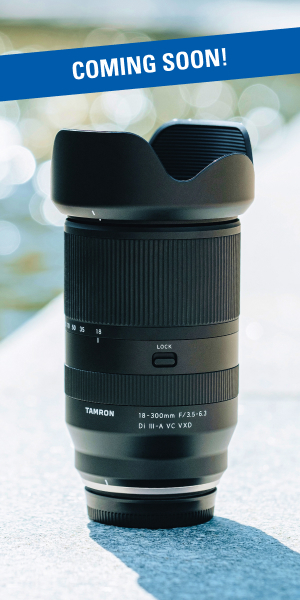La photographie à longue exposition de jour est une technique puissante qui permet aux photographes de transformer des scènes de jour ordinaires en images éthérées et rêveuses. En utilisant des vitesses d'obturation lentes et des filtres spécialisés, vous pouvez estomper de manière créative les mouvements, comme l'eau qui coule ou les nuages qui dérivent, tout en conservant des environnements nets et détaillés. Grâce à la précision et à la polyvalence des objectifs Tamron, vos photos en pose longue de jour peuvent atteindre de nouveaux niveaux de clarté et d'impact artistique.
Ce que vous apprendrez dans cet article :
- Comment choisir le bon filtre à densité neutre (ND) pour les poses longues de jour ?
- Pourquoi le mode manuel est essentiel pour un contrôle créatif total
- Comment utiliser l'histogramme de votre appareil photo pour éviter les tons clairs trop prononcés ?
- Conseils pour l'utilisation d'un trépied et d'une minuterie afin d'éviter le bougé de l'appareil photo
- Comment un filtre polarisant peut réduire les reflets et améliorer vos images
Images et conseils par Jose Mostajo, ambassadeur Tamron
CONSEIL 1 : Choisir le bon filtre ND pour la photographie de jour en pose longue
Pour atteindre l'objectif de effet de mouvement soyeux en plein jour, il est essentiel d'utiliser un filtre à densité neutre (ND) puissant. L'utilisation d'un filtre à densité neutre (ND) puissant est essentielle. Filtre ND64 ou ND1000 réduit considérablement la quantité de lumière entrant dans l'objectif, ce qui vous permet d'utiliser des vitesses d'obturation plus lentes sans surexposer l'image. Il s'agit d'un élément essentiel de la réussite de la photographie en pose longue de jour, qui permet de capturer le mouvement de l'eau, des nuages et même des rues animées avec un effet de fluidité et de douceur.
CONSEIL 2 : Prendre des photos en mode manuel complet pour un contrôle total de l'exposition

Lorsque vous pratiquez la photographie à longue exposition pendant la journée, la prise de vue en mode manuel complet (M) vous donne la liberté de régler la vitesse d'obturation, l'ouverture et la sensibilité ISO de manière indépendante. Les modes tels que A (priorité à l'ouverture) ou S (priorité à la vitesse d'obturation) peuvent annuler vos intentions en matière d'exposition, en particulier lorsque vous travaillez avec des filtres ND. Expérimentez différentes vitesses d'obturation en fonction du mouvement du sujet - l'eau en mouvement, par exemple, peut nécessiter une exposition plus longue que des nuages à la dérive.
CONSEIL 3 : Surveillez l'histogramme pour éviter les baisses de luminosité
Après avoir pris votre photo en exposition longue, examinez votre histogramme pour vérifier que l'exposition est correcte. Les conditions lumineuses peuvent facilement entraîner une perte de luminosité, en particulier sur les surfaces réfléchissantes comme l'eau. Ajustez vos paramètres d'exposition ou l'intensité du filtre ND si nécessaire pour conserver les détails des hautes lumières, en veillant à ce que l'image reste modifiable en post-traitement et conserve sa plage dynamique.
CONSEIL 4 : Utilisez un trépied et une minuterie pour éliminer le bougé de l'appareil photo

A un trépied solide est indispensable pour les expositions longues. Le moindre mouvement peut créer un flou indésirable lorsque la vitesse d'obturation est lente. Utilisez un retardateur de 2 secondes, un déclencheur à câble ou une télécommande sans fil pour déclencher l'obturateur sans toucher l'appareil photo. Cette technique simple est essentielle pour produire des photos nettes et claires en exposition longue à la lumière du jour.
CONSEIL 5 : Ajoutez un filtre polarisant pour réduire l'éblouissement et augmenter le contraste.

Combiner un polariseur circulaire avec votre filtre ND peut améliorer vos images diurnes à longue exposition en réduisant l'éblouissement de la surface de l'eau et en augmentant le contraste du ciel. Ceci est particulièrement utile pour photographier des rivières, des cascades ou des scènes côtières en plein soleil. Le polariseur complète le filtre ND, donnant à votre image une plus grande saturation des couleurs et un aspect plus raffiné et professionnel.
Conclusion : Transformez vos photos d'extérieur avec la photographie à longue exposition de jour
La photographie de jour en pose longue ouvre un monde de possibilités créatives en capturant le mouvement dans des images fixes d'une qualité surréaliste et artistique. Avec le matériel adéquat, notamment des filtres ND et polarisants puissants, un trépied stable et des objectifs Tamron de précision, vous pouvez transformer des scènes quotidiennes en histoires visuelles captivantes. Prêt à commencer ? Explorez la gamme d'objectifs haute performance Tamron et élevez votre photographie longue exposition à de nouveaux sommets.
Découvrez les objectifs Tamron lors d'une revendeur Tamron agréé dans votre région ou visitez le site Magasin TAMRON aujourd'hui.
Plus de conseils photo | Regarder les vidéos | En savoir plus sur les objectifs Tamron | Galerie de photos

